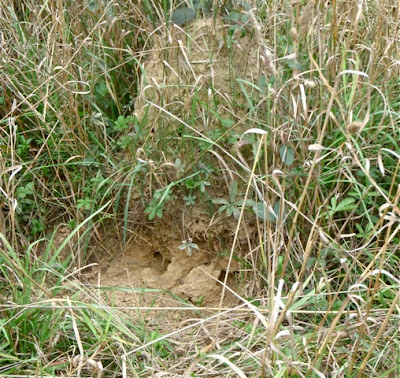This full record survey was made on 28th when changes were taking place on the riverside - after the hot summer..
It was an ideal day, with high cloud , sun, not much wind (WNW) and the ground still very dry.The Blackthorn fruits were mixed in with bramble fruits and hazels were alive with singing birds catching the early sun as it had been a cool night. Hazel leaves were turning yellow but not yet falling and the ground was littered with acorns, The leaves of the old oaks were still green but curled, their shapes having been caused by the intense heat and strong winds of previous weeks. Maples were still green but with with clumps of brown winged seeds. Fine grasses on the slopes were full of active insects and amongst the grasses tall anthills could now be seen. 'Sussex anthills' rather than the giant types seen elsewhere in the world, and not usually obvious until grasses die down.
These anthills are important for green woodpeckers which have always occupied the area. They do not migrate but traditionally stay in the same very local area provided their ant food sources are available and there are large trees for them to nest in. nearby. They make or reuse nest holes in large branches or trunks, like great spotted woodpeckers. They are quite often seen flying up from the long grasses where they have been feeding unseen around the bases of the anthills:
This anthill shows where the green woodpecker has been feeding on ants at the base of the hill, unseen, as the 'top' of the narrow hill is just visible near the top of the photo.
In the winter if there is heavy snowfall the green woodpeckers have been seen digging in the snow where drains run under the fields, preventing the ground from freezing,
The good weather prevailed and with it the sounds of the landscape here. Birdsong was dominant after what seemed like a long silent spell during the hot weather. The only other sound was the thud of acorns falling onto the dry ground. Poplars were rapidly losing their leaves and did not contribute to the noise as often happens in windy summer conditions with noisily rustling leaves.
House sparrows (c80) were by far the most numerous bird, preening and singing in the sun in hedge colonies. What a difference from August - robins (32) were seen singing short songs, some loudly others 'chinking' their usual autumn call. Wrens were still few in number (8) most not singing yet. Goldcrests (5) were heard calling and seen fast-foraging directly above me in the old oaks, not far away from the conifers where they nest. Always seen but in small numbers, dunnocks were keeping under the low undergrowth and mossy roots (2). Blue ts (39) and great ts (12) were very active, swinging from bramble shoots, foraging on twig islands and high up amongst climbing dog rose hips, still often invisible and seen only when they fly out of a thicket and into the next along the river. Moving much faster, chiffchaffs (5) were visiting each twig on a chosen tree and could be heard making contact calls - easily located whilst blackcaps (4) foraged at a slower pace also calling. Both these species are well known to overwinter here in small numbers when most migrant warblers leave our shores for warmer climates. These may be birds which migrate here from even colder climates or may be the summer birds staying put. Some of the blackbirds and song thrushes here over the summer have been migrants which have now left, leaving the resident birds - 19 blackbirds, one or two still moulting, and just one song thrush were seen today
Goldfinches have been present in good numbers feeding on abundant seeds from the hot summer and today there were 22 in several groups, softly calling together from thickets. One female bullfinch was seen perched in the blackthorn. Trees held wood pigeons in small numbers, with others feeding on short grass (22) whilst 3 carrion crows were on their usual field under the tree where they nest. Three magpies were seen flying across near two jackdaws whilst a jay called aggressively from a small tree at another close by (2). A well known old oak, called 'the Heron Tree' stands on the steep river bank overlooking a drainage basin and today a single grey heron was seen heading towards it, leisurely flapping whilst three herring gulls flew north, towards the school, calling. Further south a common buzzard was sailing over the river course. About 25 starlings, some flying in a group and others singing softly from their ivy roost were seen.
Several nuthatches were present in various trees, one making a horizontal walk along a bough extracting insects from the bark, loudly calling down at me. Another was tapping on the trunk of an ash tree and others were seen in other trees and heard calling (total 8)- time to sort out territories now that this year's juveniles are grown. A single great-spotted woodpecker was seen then heard tapping - but not drumming. The probable presence of a sparrowhawk was noted as it had left a neat pile of woodpigeon feathers on a footpath.
Insects such as craneflies were very numerous over the ponds and river.
Ten Speckled Wood butterflies were seen in places in semi shade and one Migrant Hawker dragonfly was ranging over the riverbank.

No comments:
Post a Comment